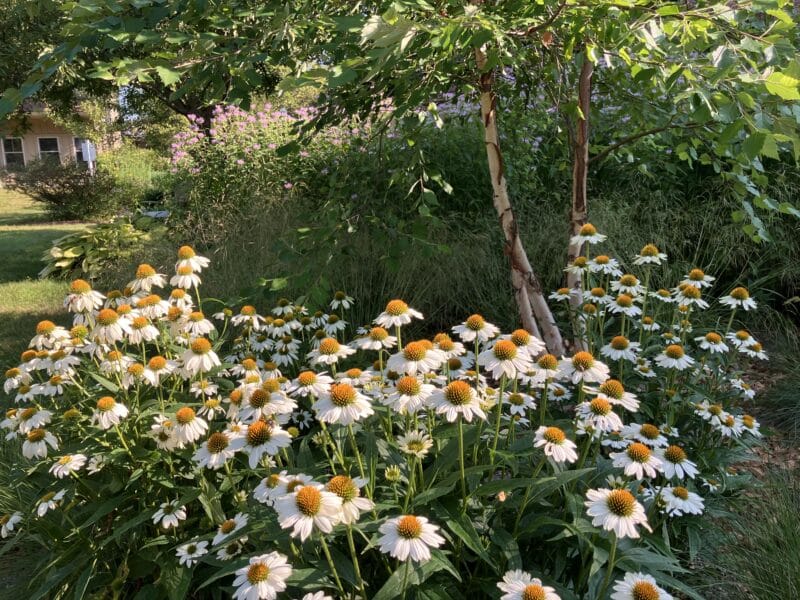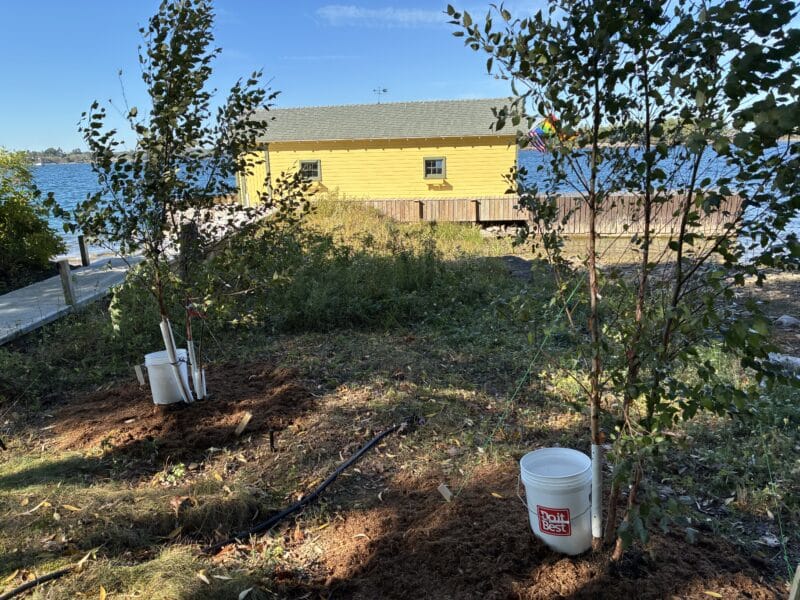One day in a diocesan staff meeting, I asked, “What is it that you want to hear, or receive, from my convention address?”
Among the 10 or so answers, two jumped out at me. “What makes you, hopeful, Bishop? Tell us that.”
The other was: “What is the Episcopal Diocese of Maine going to do in the next year to encourage hope?”
We live now in a moment that most of us have never known. It’s a time of deep division, cruelty, and instability, yet it’s also a time of resistance and community and courage and leadership.
Jane Goodall, the great British primatologist and anthropologist and chimpanzee researcher who died earlier this month at age 91, defined hope as a “dogged determination” to take action to create a better future, not a passive wish for things to be fine. She always said that hope is what keeps people motivated to act in the face of despair, and that taking action is what generates more hope.
I want to talk about hope and action today, and also about trees and women.
Martin Luther famously (although apocryphally) said that If he knew the world were ending tomorrow he would plant an apple tree today. Why did Martin Luther say to plant a tree? What do trees do for us, and for the earth? He didn’t know at the time that:
- They produce oxygen and absorb carbon dioxide from the atmosphere which combats climate change.
- They regulate water and prevent flooding: Tree roots absorb rainwater and their canopies reduce the force of rainfall which helps to prevent soil erosion and reduce flooding.
- They provide habitats for wildlife, and shelter for a vast numbers of species
- Trees provide shade, which cools the air
- What Martin Luther did know, what we know, is that planting a tree is a statement of faith. We don’t know about tomorrow, but we know who holds our hand.
Arborists and horticulturalists would say, “Betula nigra.” Most of us would say, “River Birch.” It’s a tree that’s easy to admire. It’s native to the Eastern United States, which is one of the reasons St. Paul’s in Brunswick made sure to plant them in their memorial garden, and it is they who introduced me to the River Birch.
As you might have guessed, the River Birch grows naturally along river banks. Mud is a natural bed for its seedlings, and the River Birch is excellent for holding stream banks, limiting the effects of erosion. The River Birch is resistant not only to the bronze birch borer, but also to summer droughts. In its DNA is the capacity to hold firm against violence, and to draw from streams of living water. Besides all of this, the River Birch is a graceful, semi-weeping tree whose beautiful, spreading limbs give light to the world, and like most birches, its leaves dance in the wind, but it’s the bark—the curlicue copper-colored bark, that makes her a tree for all seasons.


Inspired by St. Paul’s in Brunswick, on Oct. 2, before closing up our cottage on an island in the Saint Lawrence Seaway, I planted two Betula Nigras.
River Birch employ a marvelous internal mechanism so they can thrive along river banks. Unlike most trees, including other birches, that produce seeds in late summer or autumn, River Birch gets a head start. Its seeds ripen in May and June, during the Great 50 Days of Easter, and Ascensiontide, just in time to take advantage of high water to float seeds downstream. Whether seeds fall directly on the ground or float away until getting stranded in a new location, they take advantage of high soil moisture to provide a good place to germinate the very same season. Here’s a teacher for how to be the church right now, the River Birch: Germinate for resistance, move with graceful beauty, and tap deep into strength within and without to keep up the dance of hope.
You have heard the Chinese proverb: The best time to plant a tree is 20 years ago, the next best time to plant a tree is today.
The second strand of this address is an invitation to take a particular action for the life of the world, to build hope. I am asking every faith community in Maine to plant a tree. It can be a lilac, or a maple, it can be a River Birch, or a pyracantha bush, a holly or an ivy, a smokebush or a cherry, a spruce or a pine. You decide. Next year at this time we’ll share photographs of our newly-planted trees, and tell the stories of who they are, why they are there, and what they are doing. Critics will say this is corny, maybe even silly, to which I say, you might be right, but aren’t there cornier and sillier things than planting trees, and are we not the ones who need to keep hope alive?
Today, the church commemorates the first Greek woman in the New Testament, Dorcas. She was a disciple who made disciples, and she was a person of industry—she got things done! Dorcas made garments and shared them with others. Her creativity, like ours, was an unleashing of imagination, inspiring a sense of purpose to care for people, and her creativity, imagination, and inspiration spread, leaping from person to person, spreading throughout Joppa.
Whether it’s a small gesture or a seismic shift, creativity sparks hope. If we plant a tree, or repair systems of injustice, accompany neighbors to immigration court, or volunteer at a food pantry, format the worship leaflet or give money to Bishopswood, our actions in the church run counter to the false standard of the world, a world that says to us “consume more, buy more, and focus on yourself!”
St Luke tells us the briefest story of Dorcas’s immense life. At that time Dorcas became ill and died. Peter is nearby, is summoned, and he arrives to see Dorcas’s friends, other widows, women whom Dorcas herself taught to sew and with whom she prayed, weeping. But these women were also doing something else: they were showing tunics and other clothing that Dorcas had made while she was with them, but let’s face it: they were doing that because surely Dorcas had taught them; surely it was she who sparked creativity and beauty and hope in each of them. The outward and visible sign of their connection were the works of their hands and the fruit of their hearts, in a local community.
The name Tabitha, another name for Dorcas, means gazelle. To follow Tabitha is to be like her, like a gazelle, leaping forward, abounding in mercy, and almost bouncing with hope, a word that comes from Old English, to hop, to leap into the future.
Back to Jane Goodall. A correspondent for the New York Times, who interviewed Dr. Goodall last year, described her experience this way:
“Preparing for that interview, I had asked virtually everyone I came across, from all walks of life, what they wanted to know from Dr. Goodall. Again and again, the answer was the same: They wanted to know where they could find hope. But I didn’t want to ask that question, because she has answered it in at least two books on the subject. So I asked her about balancing hope — which she found in human intellect, in the resilience of nature, in the power of young people and in the indomitable human spirit — with false hope, sometimes called ‘hopium.’ She didn’t hesitate. ‘Hope isn’t just wishful thinking,’ she said, telling us to imagine a long, dark tunnel with a little star at the end representing hope.
‘There’s no good sitting at the mouth of the tunnel and wishing that that hope would come to us,’ she said. ‘We’ve got to roll up our sleeves. The Bible says, gird your loins. I love that. I’m not quite sure what it means, but let’s gird our loins. And we’ve got to climb over, crawl under, work around all the obstacles that lie between us and the star.’”
There’s another woman whom I want to bring into the room this morning. She’s a former chief-nursing-officer-turned priest, then Bishop of London. Soon she will be Archbishop of Canterbury, leading a part of our church that only three years ago denied the spouses of gay and lesbian bishops from attending the Lambeth Conference; the same church kept out Bishop Gene Robinson 14 years earlier. And now a woman not unlike Dorcas-Tabitha leaps into our view, and is for me a sure and shining sign of actual hope.
We ought to acclaim not only the future her appointment points us toward, but also her significant experience as a pastor, shepherding a local flock in a parish in London. When she became Bishop of London, her devotion to Christian practice, to the rhythm of daily prayer, led her to convert the former laundry of the bishop’s residence into an oratory for daily Holy Communion. To sustain hope we must root ourselves in prayer and contemplation, and to put things together again requires us to stay open, to regulate our internal temperature as well as the way we speak and treat one another. A wise mentor once said, “we will not be remembered for what we built, but what we repaired,” and my deepest intuition tells me that the next Archbishop will be an incarnation of this truth.
Friends in Christ Jesus, called to be the Episcopal Church in Maine: The work of ministry, yours and mine, and of the entire Christian community, is to release the creativity and generosity which God gives us anew every morning.
If I’m exhorting us to be the church, always remember that I’m exhorting myself. I don’t get it right most days, but I believe and know in the power of resurrection to lead me from death to life, and to lead us and every church in every county in this state that hope is alive. Peter said to Dorcas “Get up!” So let’s listen to the Risen Christ saying to us, “My cross became a way to live, so get up, let’s go!”
I end with a poem, composed by yet another wise woman, Joan Erikson. It was printed on the back of her funeral leaflet. Her late husband, the psychoanalyst, Erik Erikson, taught us to look at how we develop throughout our entire lives.
Joan helped us recover the value of play and joy, integrating her devout Anglican faith with a sharp intellect and whit:
The word “hope” the learned say
is derived from the short one “hop.”
and buds out into “leap.”
Plato, in his turn, says that the leaping of young creatures
is the essence of play
—so be it!
To hope, then, means to take a playful leap into the future
—to dare to spring from firm ground—to play trustingly, invest energy, laughter;
And one good hop encourages another—on then with the dance.